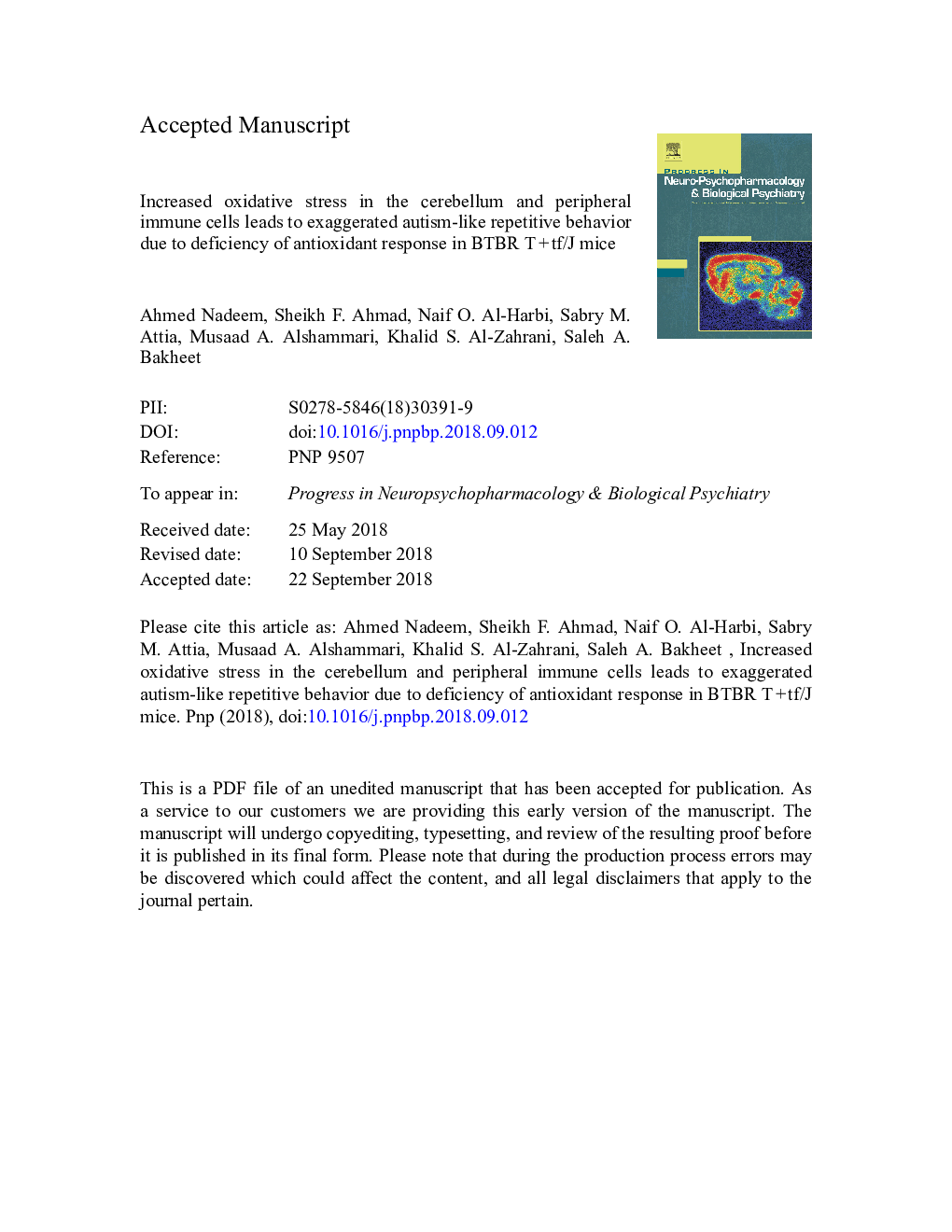| کد مقاله | کد نشریه | سال انتشار | مقاله انگلیسی | نسخه تمام متن |
|---|---|---|---|---|
| 11030738 | 1646163 | 2019 | 42 صفحه PDF | دانلود رایگان |
عنوان انگلیسی مقاله ISI
Increased oxidative stress in the cerebellum and peripheral immune cells leads to exaggerated autism-like repetitive behavior due to deficiency of antioxidant response in BTBR Tâ¯+â¯tf/J mice
دانلود مقاله + سفارش ترجمه
دانلود مقاله ISI انگلیسی
رایگان برای ایرانیان
کلمات کلیدی
GPXiNOSNox2ROS - ROSEnzymatic antioxidants - آنتی اکسیدان های آنزیمیAutism - اوتیسم یا درخودماندگیNADPH oxidase - اکسیداز NADPH Oxidants - اکسیدان هاSOD - سدImmune cells - سلول های ایمنیinducible nitric oxide synthase - سنتاز اکسید نیتریک القاییSuperoxide dismutase - سوکسوکس دیسموتازCerebellum - مخچهglutathione reductase - گلوتاتیون ردوکتازglutathione peroxidase - گلوتاتیون پراکسیدازReactive oxygen species - گونههای فعال اکسیژن
موضوعات مرتبط
علوم زیستی و بیوفناوری
علم عصب شناسی
روانپزشکی بیولوژیکی
پیش نمایش صفحه اول مقاله

چکیده انگلیسی
Autism is a neurodevelopmental disorder that affects social cognitive abilities resulting in communication or sensory deficits, and stereotyped behaviors in millions of people worldwide. Oxidant-antioxidant imbalance contributes significantly to the neurobehavioral dysregulations and severity of symptoms in patients with autism, however it has not been explored earlier whether it affects autism-like behavior directly. Therefore, we investigated oxidant-antioxidant balance in peripheral immune cells (neutrophils and CD3+ T cells) and cerebellum of BTBR Tâ¯+â¯tf/J (BTBR) mice which show autism-like behavior and the social C57BL/6â¯J (C57) mice. Further, we utilized buthionine sulfoximine (BSO), a glutathione depleting agent to assess the impact of oxidant-antioxidant dysregulation on autism-like behavior. Our study shows that BTBR mice have increased lipid/protein oxidation products in cerebellum and neutrophils/CD3+ T cells along with increased NADPH oxidase (NOX2) and inducible nitric oxide synthase (iNOS) expression. This was concurrent with lower levels of glutathione and enzymatic antioxidants such as superoxide dismutase (SOD) and glutathione peroxidase (GPx) in the cerebellum and peripheral immune cells. BSO administration led to further lowering of glutathione with a concurrent upregulation of iNOS, and NOX2 in cerebellum and peripheral immune cells. However, there was deficiency of an adaptive antioxidant response which was associated with exaggerated repetitive behaviors in BTBR mice. On the other hand, C57 mice also had increased oxidative stress after BSO treatment, however there was an enzymatic antioxidant response both in cerebellum and periphery. Overall, this study suggests that BTBR mice have increased oxidative stress with a deficient enzymatic antioxidant response that is associated with autism-like repetitive behaviors.
ناشر
Database: Elsevier - ScienceDirect (ساینس دایرکت)
Journal: Progress in Neuro-Psychopharmacology and Biological Psychiatry - Volume 89, 8 March 2019, Pages 245-253
Journal: Progress in Neuro-Psychopharmacology and Biological Psychiatry - Volume 89, 8 March 2019, Pages 245-253
نویسندگان
Ahmed Nadeem, Sheikh F. Ahmad, Naif O. Al-Harbi, Sabry M. Attia, Musaad A. Alshammari, Khalid S. Alzahrani, Saleh A. Bakheet,